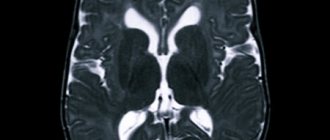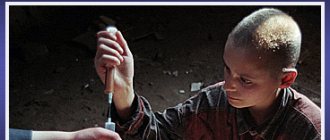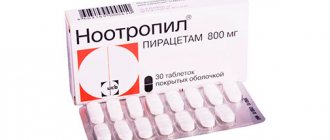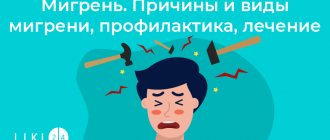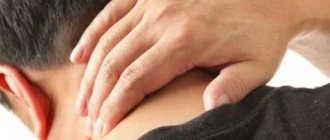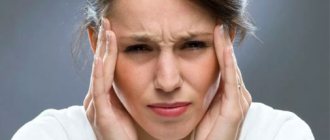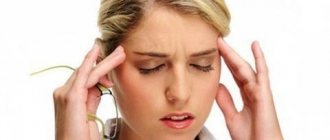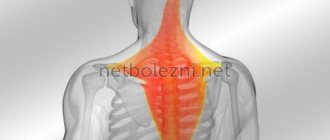Tension headache - symptoms
Tension headaches mean bilateral painful sensations in the skull area that cover the entire head (an attack can start from one point and gradually spread to the occipital region), and sometimes also spread to the cervical region and shoulders. Patients complain of a feeling of a squeezing hoop on the head.
The feeling of a “squeezing” hoop is one of the symptoms of tension headaches in children.
Along with non-drug methods of prevention and treatment, doctors prescribe sedatives to young patients that help normalize the emotional background and cope with stress, fears, anxiety and insomnia. After all, all these are factors that provoke tension-type headache.
To establish the normal functioning of the body’s compensatory and adaptive mechanisms that protect against stress factors, the doctor may prescribe Tenoten for Children, a medicine with a mild sedative effect.
- The attack is of low (moderate) intensity and usually lasts half an hour, but can last for several days in a row (up to a week).
- Most often, tension-type headache occurs during the daytime. The pain, as a rule, does not intensify with any physical activity, while a simple touch to the head can increase the patient’s suffering.
- Among other signs, experts note anxiety, increased irritability and excitability of the child. Children may also complain of discomfort with loud noises and bright lights. If the pain is accompanied by vomiting, then it is not tension-type headache.
- If attacks occur more often than 15 times in 30 days for three months or more, a diagnosis of chronic tension-type headache is made.
Tension headache in children
The middle of the school year is a busy time for a neurologist. If you don’t attract anyone to the clinic in the summer, then a new season opens in the fall and continues actively in the winter.
What complaints do you think children come with? Don't guess, there are many of them.
But among all the variety of complaints, there is the most popular - headache.
Most parents react to this condition extremely emotionally.
It happens that when you come to the doctor, you are immediately asked to immediately begin a deep and thorough diagnosis: MRI, CT, REG, radiography of the skull and, of course, ultrasound of the vessels of the head and neck.
But this is not always required, since not every headache is dangerous.
Fortunately, most children who come to an appointment always describe the same diagnosis - tension headache. It is not difficult to diagnose this disease; it has quite simple and clear signs.
The pain almost always occurs in the afternoon; it does not cause suffering to the child, but creates a feeling of discomfort.
This headache is not characterized by nausea or vomiting, although loud noises or bright lights may be irritating.
It has a bilateral distribution and often occurs in the temples and back of the head, and is similar in nature to pressure or compression.
Many children complain of pain when pressing the neck muscles - this is not surprising, because the diagnosis got its name due to the assumption that pain is caused by tension in the muscles of the head and neck.
It is difficult to name a specific cause that causes tension headaches. Most often it is a whole complex of factors. That is why it worsens during the school year.
A sharp change in the daily routine with early rises and late bedtimes, irregular and unbalanced nutrition, unusual physical activity, aggravated emotional experiences, large amounts of homework, additional extracurricular activities - all this makes a significant contribution to the development of the disease.
Read also: School and stress: when a child does not study, but suffers
Another significant factor can be considered being in one position for a long time - this always negatively affects the condition of the muscles. Additionally, digital devices have a big impact.
Modern children constantly interact with phones, tablets, computers, etc., attention often switches from one process to another. Such multitasking has a negative impact on the nervous system, depleting it, which is manifested by impaired attention, memory deterioration and decreased motivation.
Where to start treatment?
The best solution is to keep a headache diary. It must reflect the time of occurrence, probable cause, nature, intensity, and duration of the headache.
It is imperative to note the medications taken, their dosages, the effect achieved and the time after which improvement occurred. In most cases, if maintained correctly, the diary allows you to make an accurate diagnosis and track the dynamics of the disease.
Parents often consider painkillers as the main treatment. This is not the best tactic. The fact is that a true tension headache is of low intensity and does not create significant restrictions on the child’s activities, and medications often have side effects that can sharply worsen the condition.
Some medications, when used frequently, no longer relieve pain; on the contrary, they increase it. This phenomenon is called overuse headache. Therefore, any use of the drug must be agreed with the attending physician.
In most cases, tension headaches are greatly relieved with a short rest. A light massage of the head and back of the neck helps greatly.
Other measures are aimed at reducing the intensity of pain and preventing it:
- Wake up and go to bed should be early (about 6-7 am and 8 pm respectively)
- Skipping meals is unacceptable.
- It is necessary to limit the use of digital devices as much as possible, especially 3-4 hours before bedtime.
- Regular, moderate physical activity is vital for any child (and even an adult).
- Some children need to limit caffeine-containing products: tea, coffee, chocolate, cocoa, energy drinks.
Bad habits must be eliminated; without this, positive dynamics are impossible (I understand that all children do not smoke or drink, but this point is necessary here.
Remember, proper organization of the educational process at school and at home significantly reduces the frequency of headaches.
In some cases, the disease occurs against a background of high emotional stress: complex family relationships, conflicts among peers and other reasons may require the intervention of a psychologist. In some cases, you can discuss with your doctor a treatment option based on the placebo effect, but keep in mind that it is strictly forbidden to use a “pacifier” without permission (without consulting a doctor).
Even considering the simplicity of the recommendations, it is quite difficult to cure a child, since treatment involves lifestyle changes (sometimes for the entire family). Fortunately, in most children the disease goes away on its own as they adapt to new conditions, but this fact does not negate a visit to the doctor.
Red flags indicating an “abnormal” headache:
1. High frequency (more than 15 times a month) and duration (more than 1 month).
2. Persistent pain in the same place for a long time.
3. Increasing headaches during mental, emotional, and physical stress, which were previously well tolerated.
4. Lack of effect from drugs that were previously effective.
5. Deterioration of the condition after medications that were previously effective.
6. Nausea and vomiting that occurs in the morning. Increased pain when coughing, sneezing.
7. Eye manifestations – strabismus, different pupil sizes in equal lighting, double vision, decreased visual acuity.
8. Dizziness, tinnitus, hearing loss.
9. Loss of body weight, fever.
10. Significant changes in the child’s behavior (aggression, depression, euphoria, sudden mood swings)
If you find even one point, be sure to show your child to the doctor.
Strength and patience to you.
Daniyar Zhuraev
Photo depositphotos.com
_______
1. Uptodate — Tension-type headache in children 2. Migraine and Tension Headache Guideline by Kaiser Permanente Washington 3. Tension-type headache in children: the Cinderella of headache disorders! Seshia SS, Abu-Arafeh I, Hershey AD. Can J Neurol Sci. 2009 Nov;36(6):687-95. Review. 4. International Classification of Headache Disorders (3rd edition) by International Headache Society 2018
The author's point of view may not coincide with the opinion of the editors
Causes of tension headaches
At the moment, the mechanism of tension headaches is not fully understood, but doctors name the factors that provoke pain:
- psychosocial stress (increased anxiety, depression);
- muscle strain (for example, strain of the neck and eye muscles);
- long-term use of aggressive medications (including analgesics, antidepressants, etc.).
Experts also note a family predisposition - TTH is often found in children whose mothers suffer from constant headaches, such as migraines.
The diagnosis is made after a thorough examination. A neurologist examines the child, palpates the head and finds out the nature of the pain - duration, intensity, frequency. Parents are advised to keep a diary with a detailed description of all episodes.
It is very important to check whether pain is associated with other diseases (infection, tumor, hormonal disorders, etc.) or injuries. For this purpose, tests and instrumental examinations (ultrasound, MRI, etc.) may be recommended for a small patient.
Preventing tension headaches
Treatment for tension-type headache is selected individually and lasts for quite a long time (depending on the underlying cause, therapy can last several months). A positive result is achieved by an integrated approach, which includes taking medications, massages, and physical activity.
But any disease is better to prevent than to treat. Knowing the likely causes of headaches in their child, parents should do everything possible to prevent attacks from recurring. To do this you need:
- provide rational, balanced nutrition;
- ensure complete healthy sleep (timely going to bed, which should last 8 hours);
- ensure a normal life schedule (do not overdo it with the child’s education - excessive mental work is also the cause of increased mental stress);
- play sports (intense physical activity, active lifestyle);
- to walk outside;
- limit time on TV and computer.
Along with non-drug methods of prevention and treatment, doctors prescribe sedatives to young patients that help normalize the emotional background and cope with stress, fears, anxiety and insomnia. After all, all these are factors that provoke tension-type headache.
To establish the normal functioning of the body’s compensatory and adaptive mechanisms that protect against stress factors, the doctor may prescribe Tenoten for Children, a medicine with a mild sedative effect.
Prevention
A number of measures reduce the risk of pathologies accompanied by headaches. This is important for those who have previously encountered cephalalgia in a child.
Prevention methods:
- Preventing injuries.
- Strengthening the immune system.
- Treatment of ARVI, acute respiratory infections, dental diseases.
- Routine immunization against infectious diseases (measles, diphtheria, rabies, rubella, hepatitis, tetanus).
- Balanced diet.
- Taking vitamin complexes.
- Maintaining a daily routine.
- Normal night's sleep (at least 10 hours).
- Preventing overloads.
- Elimination of stress factors, sources of anxiety, restlessness.
It is recommended to regularly undergo preventive medical examinations and seek medical help if you have health complaints.
Headache in children is common and is often diagnosed at 4 years of age. During this period, the child may encounter diseases that cause pain. To get rid of a disease, you need to determine its cause. After this, comprehensive treatment and prevention are prescribed.

